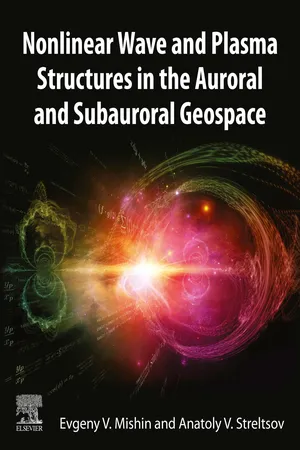
eBook - ePub
Nonlinear Wave and Plasma Structures in the Auroral and Subauroral Geospace
- 632 pages
- English
- ePUB (mobile friendly)
- Available on iOS & Android
eBook - ePub
Nonlinear Wave and Plasma Structures in the Auroral and Subauroral Geospace
About this book
Nonlinear Wave and Plasma Structures in the Auroral and Subauroral Geospace presents a comprehensive examination of the self-consistent processes leading to multiscale electromagnetic and plasma structures in the magnetosphere and ionosphere near the plasmapause, particularly in the auroral and subauroral geospace. It utilizes simulations and a large number of relevant in situ measurements conducted by the most recent satellite missions, as well as ground-based optical and radar observations to verify the conclusions and analysis. Including several case studies of observations related to prominent geospacer events, the book also provides experimental and numerical results throughout the chapters to further enhance understanding of how the same physical mechanisms produce different phenomena at different regions of the near-Earth space environment.
Additionally, the comprehensive description of mechanisms responsible for space weather effects will give readers a broad foundation of wave and particle processes in the near-Earth magnetosphere. As such, Nonlinear Wave and Plasma Structures in the Auroral and Subauroral Geospace Nonlinear Wave and Plasma Structures in the Auroral and Subauroral Geospace is a cutting-edge reference for space physicists looking to better understand plasma physics in geospace.
- Presents a unified approach to wave and particle phenomena occurring in the auroral and subauroral geospace
- Summarizes the most current theoretical concepts related to the generation of the large-scale electric field near the plasmapause by flows of hot plasma from the reconnection site
- Includes case studies of the observations related to the most "famous events during the last 20 years as well as a large number of experimental and numerical results illustrated throughout the text
Frequently asked questions
Yes, you can cancel anytime from the Subscription tab in your account settings on the Perlego website. Your subscription will stay active until the end of your current billing period. Learn how to cancel your subscription.
At the moment all of our mobile-responsive ePub books are available to download via the app. Most of our PDFs are also available to download and we're working on making the final remaining ones downloadable now. Learn more here.
Perlego offers two plans: Essential and Complete
- Essential is ideal for learners and professionals who enjoy exploring a wide range of subjects. Access the Essential Library with 800,000+ trusted titles and best-sellers across business, personal growth, and the humanities. Includes unlimited reading time and Standard Read Aloud voice.
- Complete: Perfect for advanced learners and researchers needing full, unrestricted access. Unlock 1.4M+ books across hundreds of subjects, including academic and specialized titles. The Complete Plan also includes advanced features like Premium Read Aloud and Research Assistant.
We are an online textbook subscription service, where you can get access to an entire online library for less than the price of a single book per month. With over 1 million books across 1000+ topics, we’ve got you covered! Learn more here.
Look out for the read-aloud symbol on your next book to see if you can listen to it. The read-aloud tool reads text aloud for you, highlighting the text as it is being read. You can pause it, speed it up and slow it down. Learn more here.
Yes! You can use the Perlego app on both iOS or Android devices to read anytime, anywhere — even offline. Perfect for commutes or when you’re on the go.
Please note we cannot support devices running on iOS 13 and Android 7 or earlier. Learn more about using the app.
Please note we cannot support devices running on iOS 13 and Android 7 or earlier. Learn more about using the app.
Yes, you can access Nonlinear Wave and Plasma Structures in the Auroral and Subauroral Geospace by Evgeny Mishin,Anatoly Streltsov in PDF and/or ePUB format, as well as other popular books in Physical Sciences & Astronomy & Astrophysics. We have over one million books available in our catalogue for you to explore.
Information
Table of contents
- Nonlinear Wave and Plasma Structures in the Auroral and Subauroral Geospace
- Cover
- Title Page
- Copyright
- Table of Contents
- Preface
- Chapter 1 Introduction
- Chapter 2 Plasma waves and instabilities
- 2.1.3 Cold plasma
- 2.1.4 Warm plasma waves
- 2.1.5 Wave propagation in inhomogeneous plasmas
- 2.1.7 Appendix A2.1: dielectric permittivity of a magnetized plasma
- Chapter 2.2 Plasma instabilities
- 2.2.3 Magnetized plasma
- 2.2.5 Current convective instability
- 2.2.8 Appendix A2.2: Dielectric permittivity of an inhomogeneous plasma
- Chapter 2.3 Nonlinear interactions
- 2.3.3 Weakly nonlinear wave interactions
- 2.3.4 Strong turbulence
- 2.3.5 Nonlinear inertial Alfvén waves
- 2.3.6 Appendix A2.3: useful formulas
- Chapter 3 Auroral geospace
- 3.1.4 Plasma beam penetration across magnetic barriers
- Chapter 3.2 Substorms
- Chapter 3.3 Multiscale aurora: structure and dynamics
- 3.3.3 Small-scale auroral arcs
- Chapter 3.4 Alfvénic aurora
- 3.4.1 Introduction
- Chapter 4 Nonlinear effects in natural and artificial aurora
- Chapter 4.2 Artificial aurora
- Chapter 4.3 Theory of Artificial and Enhanced Aurora
- 4.3.2 Beam-plasma discharge in artificial aurora experiments
- 4.3.3 Theory of descending artificial plasma layers
- Chapter 4.4 E/F-region turbulent heating
- 4.4.4 Plasma chemistry in the heated E-Region
- Chapter 5 Subauroral geospace
- Chapter 5.2 Subauroral ULF wave structures
- Chapter 5.3 Subauroral arcs
- Chapter 5.4 Generation and dynamics of subauroral VLF whistlers
- 5.4.1 Guiding of VLF waves by density ducts
- Index